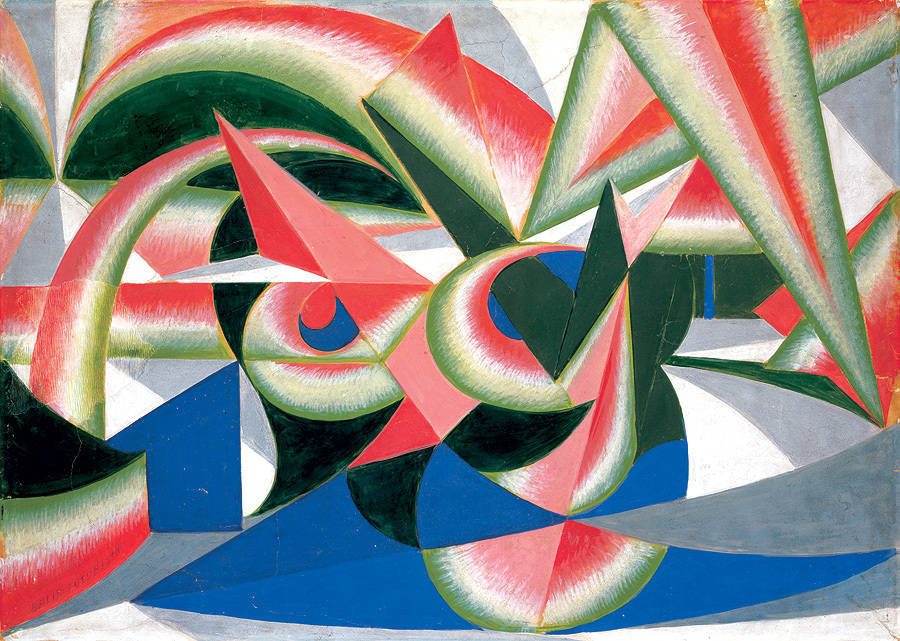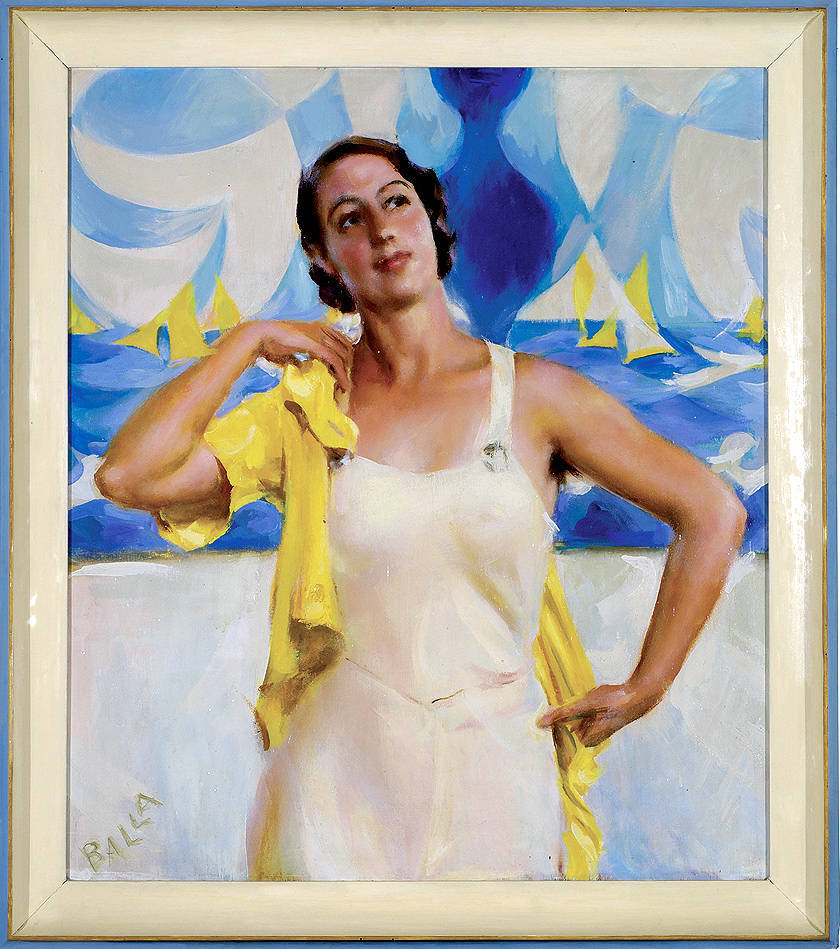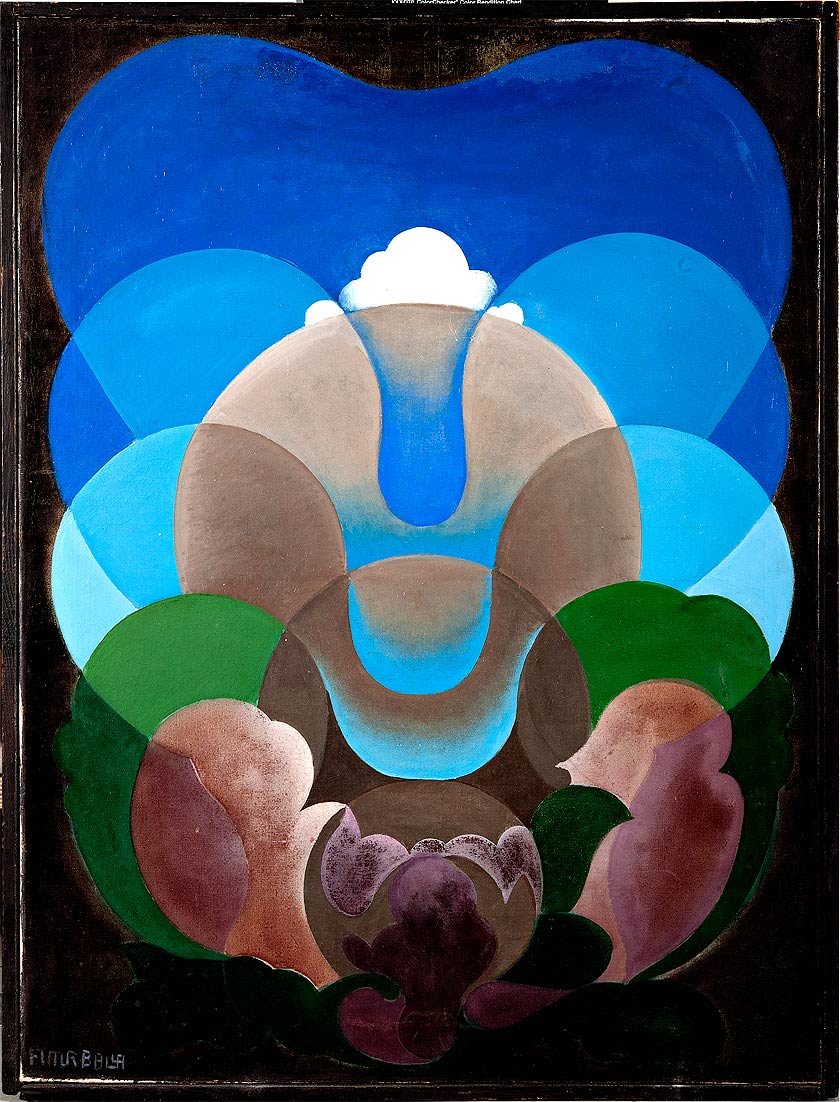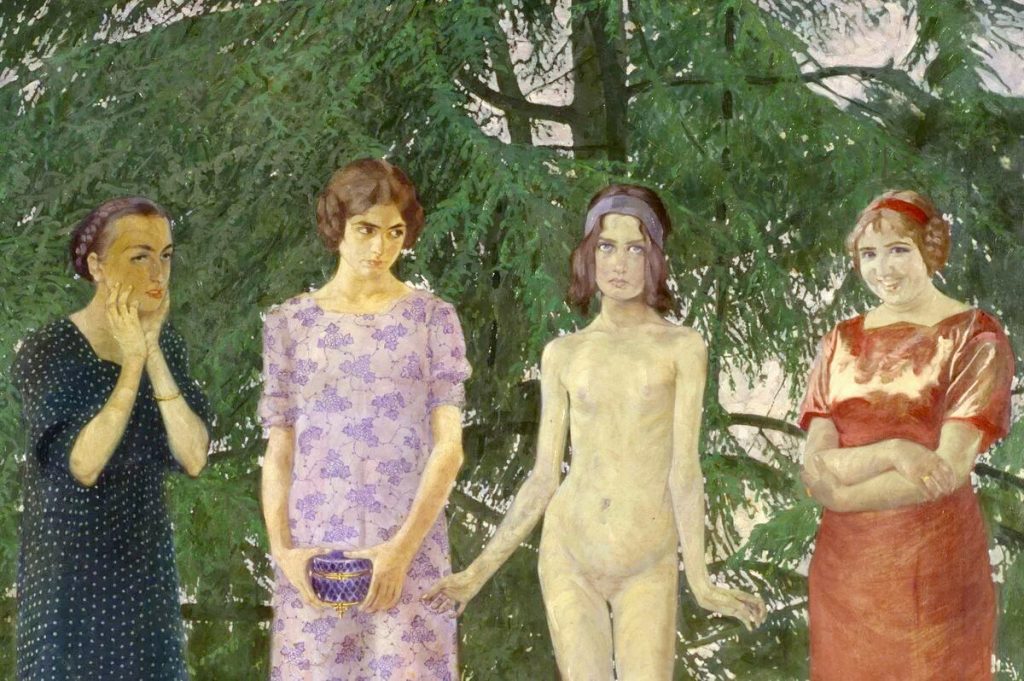GIACOMO BALLA
Astrattista Futurista
12 september – 8 december 2015 Colourful Balla at “Villa dei Capolavori”.
The exhibition GIACOMO BALLA Astrattista Futurista set at Magnani Rocca Foundation in Mamiano di Traverseolo, near Parma, from September 12 until December 8 2015, curated by Elena Gigli and Stefano Roffi, intends to present Balla’s (Torino 1871 – Roma 1958) artistic advancement through the analysis of “Futuristic Reconstruction of Universe” Manifesto, one of the most revolutionary theoretical 20th century art text, during the centenary of its publication; undersigned “Astrattista Futurista” by Balla himself and Fortunato Depero.

The exhibition is arranged in themes, retracing the 1915 Manifesto’s foundations:
- ABSTRACT / ASTRATTO – the light of the pastels, realized in the first years of the last century at Villa Borghese – in particular Fontana (che piange), property of Banca d’Italia, never exhibited before – and the light emerging in the studies of iris, dated 1912, concluding with the fascinating Finestra di Düsseldorf, the last pictorial document of the tormented passage from objective painting to abstract, work found by Luce and Elica Balla in 1968.
- DYNAMIC / DINAMICO – the velocity in swallows’ flight, in speeding cars, in abstract velocity.
- COMPLETELY TRANSPARENT / TRASPARENTISSIMO – Stagioni and Trasformazioni Forme e Spirito’s cycles.
- COLOURFUL and EXTREMELY BRIGHT / COLORATISSIMO E LUMINOSISSIMO – he artificial landscape in Linee forze di paesaggio + sera dated 1917-18, never shown in an exhibition before, Feu d’artifice and Fiori , visible with the 3D effect.
- AUTONOMOUS / AUTONOMO – Selfportraits, like Balla’s Ecce Homo.
- TRANSFORMABLE / TRASFORMABILE – the Futuristic cloth and furniture, from Casa Balla, a colour explosion.
- DRAMATIC / DRAMMATICO – the agreement of the mobilization for war through the work Dimostrazione interventista, dated 1915, recently rediscovered on the back of Verginità painting, dated 1925.
- EPHEMERAL / VOLATILE – the feminine figure: from the first pastel Elisa che cuce (1898) to Dubbio (1907-1908), from the feminine portraits of the ’20s to Noi 4 allo specchio (1945).
- EXPLODING / SCOPPIANTE – lthe line of velocity in sculptures: from the wholly red Pugno di Boccioni, to Complesso Plastico (studies and projects from Casa Balla). The works arrive from prestigious private collections and from the most important Italian museums, which safeguard Balla’s paintings, among which Galleria Nazionale d’Arte Moderna in Rome, Uffizi in Florence, Museo del Novecento in Milan, Galleria d’Arte Moderna in Turim. The exhibition ends with some original document materials (photographies, catalogues, manifestos) arriving from Archivio Gigli in Rome.

Here the intents declared in the first part of the Manifesto:
“The Futuristic Painting rose as advanced and consolidation of Impressionist, plastic dynamism and shaping of the atmosphere, simultaneous penetration of levels and state of mind… We, futurist, Balla and Depero, want to realize this total fusion to rebuild the universe, brightening it, that it to say, entirely reshaping it. We’ll embody the invisible, the impalpable, the imponderable, the imperceptible. We’ll find the equal abstract of all the shapes and of all the elements of Universe, then, we’ll combine them together, following our inspiration’s passing caprices … “Parolibero” Marinetti has enthusiastically told us: “Art, before us, has been memory, anguished remembrance of a lost Object (happiness, love, landscape), therefore nostalgia, statics, pain, distance. But with Futurism, art becomes art-action, that is will, optimism, aggression, possession, penetration, joy, coarse reality in art, geometrical splendour of forces, projection forward. So, Art becomes Presence, new Object, new Reality, shaped with the abstract elements of the Universe. The hands of the artists, tied to the past, suffered because of the lost Object; our hands yearn to create a new Object” … The inventions contained in this manifesto are absolute creations, entirely created by Italian Futurism. Any French, Russian, English, German Artist grasped, before us, something similar or analogous. Just the italian talent, that is the highest genius in construction and architecture, could realize the plastic abstract complex. For this reason, Futurism has defined his Style, which will inevitably command for many centuries, in terms of sensibility.”

In 1917 Balla trials a series of breakdown of nature, from a purely theosophic viewpoint (Trasformazioni Forme e Spirito). In 1918, Balla exhibits at Anton Giulio Bragaglia’s Gallery, together with other operas, based upon the theme of the entrance in war, Complesso plastico, published in the Manifesto in 1915, along with sixteen paintings, which tackle the theme of “landscape vigour”, gathered with different sensations.
In addition to these researches, the study of nature prevails in Stagioni’s motif: starting with spring’s fluidity, softness or expansion, proceeding with Summer’s scent, to a dramatic autumn vanishing. These are experimental projects aimed at particular abstract research typically European, but at the same time completely different and original, compared with abstract researches by prevalent painters of these years, certainly known by Balla (like Kandinskij and Arp, Léger and Larionov, Mondrian and Gončarova).
This is for Balla a period absolutely international, which finds its finale with the Parish journey in 1925, on the occasion of the “Exposition des Arts Decoratifs et Industriels Modernes”, exhibition undoubtedly significant because it marks the beginning of Art Decò.
Ricostruzione Futurista dell’Universo Manifesto
March 11th 1915, together with Fortunato Depero, Giacomo Balla signs the Manifesto of Ricostruzione Futurista dell’Universo, which represents one of the most significant step of the futuristic aesthetics’ evolution. As a result of this Manifesto, Futuristic will finds its wholly maturation to defined once again every single artistic field, following its theories, and to re-establish the external world’s shapes, involving also daily life’s objects and environment.
This artistic value is not an historic news, indeed it is one of the Jungendstil poetry’s fundamental principal, but if this one discerns its idea of art as an absolute value, now the purposes are completely different: for Futurist art is not an end unto itself and it has not as purpose the purest aesthetic experience, but art becomes instrument to affirm a different concept of life and of its renewal, where the aim for a cultural transformation stands out, explaining the idea of modernity felt by Futurist. The most important innovation proclaimed in Ricostruzione Futurista dell’Universo Manifesto is the project to influence all the aspect of everyday life, following the futuristic aesthetic thought. The research areas seem unlimited: décor, objects, scenography, fashion, publishing, advertising graphic: nothing seems to be irrelevant to the two artists’ sensitivity. The Futurists imposed their mark since the first renowned “evenings”, throughout the artists – authors – orators wore clothes, draw by themselves, and masks that evoked the robotisation and the mechanization of man.
GIACOMO BALLA Astrattista Futurista
12 september – 8 december 2015
Magnani Rocca Foundation, via Fondazione Magnani Rocca 4, Mamiano di Traversetolo (Parma) Italy. Getting here.
OPENING TIMES
From Tuesday to Friday continuous hours from 10 to 18 – Saturday, Sunday and Holidays continuous hours from 10 to 19. The ticket office is open until 1 hour before museum closing. Close every Monday, except for Monday 7th December. Admission Prices: € 9,00, for visiting both temporary and permanent collection – € 5,00 school groups.
Info and Group visits booking: tel. 0521 848327 / 848148 Fax 0521 848337 info@magnanirocca.it www.magnanirocca.it Guided tour every Tuesday at 15.30 and every Sunday at 16.00; advanced booking is not necessary, € 12,00 per person (entrance and tour).
Restaurant in the inner court yard of the museum tel. 0521 848135
Exhibition and catalogue (Silvana Editoriale) curated by Elena Gigli and Stefano Roffi. Catalogue contains essays written by Antonio Carnevale, Mario Ceppi, Elena Gigli, Giovanni Lista, Stefano Roffi.
PARTNERS
The exhibition is realized thanks to: FONDAZIONE CARIPARMA, CARIPARMA CRÉDIT AGRICOLE.
Media partners: Gazzetta di Parma, Kreativehouse.
Technical Sponsors: Angeli Cornici, Aon Artscope Fine Art Insurance Brokers, Butterfly Transport, Hotel Palace Maria Luigia, SINA Fine Italian Hotels, TEP, Società per la Mobilità e il Trasporto Pubblico.
Dove
Fondazione Magnani Rocca,
via Fondazione Magnani Rocca 4,
Mamiano di Traversetolo (Parma).


